
Text O of the rongorongo corpus, the Berlin tablet, is one of two dozen surviving rongorongo texts.

Text O of the rongorongo corpus, the Berlin tablet, is one of two dozen surviving rongorongo texts.
O is the standard designation, from Barthel (1958). Fischer (1997) refers to it as RR22.
It is also known as the Boomerang because of its bent shape.
Museum für Völkerkunde, Berlin. Catalog # VI 4878 (Inventory # I 3/83).
A fluted piece of gnarled driftwood, 103 × 12.5/10 × 5.2 cm, this is the most massive rongorongo artifact to survive, as well as the most fragile. It was heavily weathered before inscription, and later it was burnt in five places and lay on side b in damp soil, probably in a cave. Fischer (1997) reports that bits flake off upon handling, and in parts even the fluting is no longer distinguishable.
Fischer (1997) believes that it was once a 'marvelous' piece, a fluted version of the Santiago Staff.
In 1882 an archaeological expedition aboard the SMS Hyäne visited Easter Island, and captain Wilhelm Geiseler purchased two tablets. The purchase had been arranged by Schlubach, the German consul in Valparaíso, at the request of Adolf Bastian, the director of the Königliches Museum für Völkerkunde in Berlin. The tablets were given to the uncle of Schlubach's wife, Alexander Salmon, Jr, who then shipped three tablets, M, N, and O, to Schlubach. When Schlubach returned to Hamburg in 1883, he sent just this one tablet to Bastian.
There are seven visible lines of glyphs on side a, with traces of eleven or twelve (if the edge was used) altogether; on side b there are traces of fluting for thirteen lines, or perhaps fourteen if the edge was used.
No glyphs can be identified on side b (Fischer 1997:497). On side a, Fischer counts ~ 187 glyphs from personal examination and an 1883 sketch by Bastian, many of which cannot be reliably identified. He estimates the original text held 1,200 to 1,300 glyphs. He hopes that a 'substantial amount' of text may be recovered through computer enhancement.
| | This section needs expansion. You can help by adding to it. (June 2008) |
| | This section needs expansion. You can help by adding to it. (June 2008) |
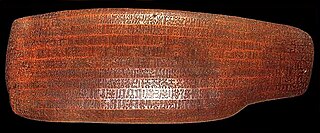
Rongorongo is a system of glyphs discovered in the 19th century on Easter Island. It is not yet known whether rongorongo represents true writing or proto-writing. Numerous attempts at decipherment have been made, but none have been successful so far. Although some calendrical and what might prove to be genealogical information has been identified, none of these glyphs can actually be read. If the system is writing and proves to be an independent invention, it would be one of very few independent inventions of writing in human history.
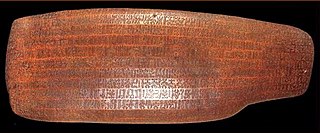
Rongorongo is a system of glyphs discovered in the 19th century on Easter Island that appears to be writing or proto-writing. Text B of the rongorongo corpus, also known as Aruku Kurenga, is one of two dozen surviving rongorongo texts.
Text C of the rongorongo corpus, also known as Mamari, is one of two dozen surviving rongorongo texts. It contains the Rapa Nui calendar.

Rongorongo is a system of glyphs discovered in the 19th century on Easter Island that appears to be writing or proto-writing. Text D of the rongorongo corpus, also known as Échancrée ("notched"), is one of two dozen surviving texts. This is the tablet that started Jaussen's collection.

Rongorongo is a system of glyphs discovered in the 19th century on Easter Island that appears to be writing or proto-writing. Text E of the rongorongo corpus, also known as Keiti, is one of two dozen known rongorongo texts, though it survives only in photographs and rubbings.
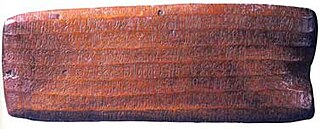
Text G of the rongorongo corpus, the smaller of two tablets located in Santiago and therefore also known as the Small Santiago tablet, is one of two dozen surviving rongorongo texts. It may include a short genealogy.

Text H of the rongorongo corpus, the larger of two tablets located in Santiago and therefore also known as the Great or Large Santiago tablet, is one of two dozen surviving rongorongo texts, and one of three recording the so-called "Grand Tradition".
Text N of the rongorongo corpus, the smaller of two tablets in Vienna and therefore also known as the Small Vienna tablet, is one of two dozen surviving rongorongo texts. It repeats much of the verso of tablet E.
Text Q of the rongorongo corpus, the smaller of two tablets in St. Petersburg and therefore also known as the Small St Petersburg tablet, is one of two dozen surviving rongorongo texts, and one of three recording the so-called "Grand Tradition".
Text P of the rongorongo corpus, the larger of two tablets in St. Petersburg and therefore also known as the Great or Large St Petersburg tablet, is one of two dozen surviving rongorongo texts, and one of three recording the so-called "Grand Tradition".

Text S of the rongorongo corpus, the larger of two tablets in Washington and therefore also known as the Great or Large Washington tablet, is one of two dozen surviving rongorongo texts.

Rongorongo is a system of glyphs discovered in the 19th century on Easter Island that appears to be writing or proto-writing. Text F of the rongorongo corpus, also known as the (Stephen) Chauvet tablet, is one of two dozen surviving texts.
Text K of the rongorongo corpus, also known as the (Small) London tablet, is one of two dozen surviving rongorongo texts. It nearly duplicates the recto of tablet G.
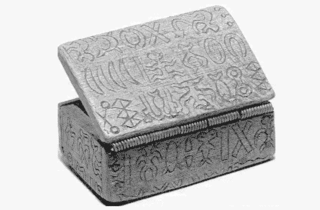
Text Y of the rongorongo corpus, known as the Paris Snuff Box, is one of two dozen surviving rongorongo texts.
Text T of the rongorongo corpus, also known as Honolulu tablet 1 or Honolulu 3629, is the only fluted tablet in the Honolulu collection and one of two dozen surviving rongorongo texts.
Text U of the rongorongo corpus, carved on a beam, also known as Honolulu tablet 2 or Honolulu 3628, is one of two dozen surviving rongorongo texts.
The fragmentary text W of the rongorongo corpus, also known as Honolulu tablet 4 or Honolulu 445, is one of two dozen surviving rongorongo texts.
Text V of the rongorongo corpus, the Honolulu oar, also known as Honolulu tablet 3 or Honolulu 3622, may be one of two dozen surviving rongorongo texts. Its authenticity has been questioned.

Text Z of the rongorongo corpus, also known as Poike, is a palimpsest inscription that may be one of two dozen surviving rongorongo texts. The authenticity of the upper text is in question.
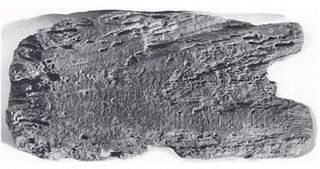
Text M of the rongorongo corpus, the larger of two tablets in Vienna and therefore also known as the Large or Great Vienna tablet, is one of two dozen surviving rongorongo texts.